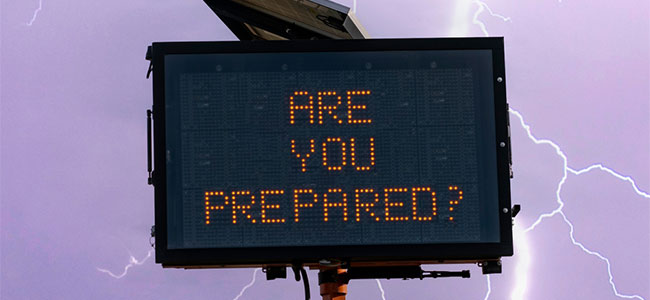
Expecting the Unexpected: Mitigating the Effects of Severe Weather with Proactive Planning
Getting ahead of something as unpredictable as severe weather can seem an impossible challenge, but understanding the four pillars of an effective response plan can help managers ensure workers stay safe and healthy no matter what's on the forecast.
- By Rachel Sweeney
- Sep 22, 2023
Process safety management has long been a priority for HR departments, particularly in businesses that deal in hazardous materials or rely on demanding physical labor. Traditionally, many of these policies have focused on the controlled elements of the worksite, like improving how hazardous materials are stored or addressing slip or fall hazards on the floor.
Now the extreme heat in the Midwest, South and Southwest regions of the U.S., hazardous air quality in the northeast and an extended hurricane season on the horizon have served as a call to action for employers. Aside from those in construction, landscaping and other skilled labor businesses whose core business functions leave workers exposed to the elements, additional employers and industries that don’t typically face these issues may need to consider new safety measures. Over the past few months, headlines—along with the Biden Administration’s extreme heat plan—have made it clear that HR teams across the nation will need to reframe employee safety measures to address a shifting environmental risk landscape and protect workers from the increasingly detrimental effects of severe weather.
Of course, mitigating environmental hazards—like heat, rain, wind or cold—isn’t as easy as addressing health and safety concerns within a facility’s day-to-day operations. Advanced technologies can help us anticipate when we might face severe weather or wildfires and how that event might impact operations, but managers do not have the power to prevent the incident from occurring altogether like they might when a trip hazard is flagged on the floor.
That means the response—rather than proactive remediation—is key to mitigating the effects of these events on the business and its workers. But that doesn’t mean that you can’t think ahead and develop contingency plans for the worst-case scenarios.
Planning for the unknown
Effective response plans are built on four pillars:
- Engineered controls. These are changes to the worksite that help counter the effects of environmental incidents. They may include things like putting up heat-absorbing barriers to protect from extreme heat, accounting for wider temperature fluctuations in facilities by prioritizing updates to ventilation and climate control systems and installing temporary drainage systems to mitigate hazards caused by heavy rainfall.
- Administrative adjustments. These are changes to administrative procedures designed to accommodate the strains associated with environmental hazards that the average worker might encounter. It may include things like updated scheduling practices (like half-shifts or longer breaks) to allow for increased rest, new site assessment protocols, adjusting a dress code and reviewing or updating leave policies to reduce issues that might arise from workers calling out due to the conditions.
- Equipment and resources. Making sure that the site has not only a plan in place for larger changes (like temporary shelters) but smaller adjustments that mitigate hazards—like personal fans, hand warmers, protective rain equipment, shaded areas and even supplements that support hydration—are also important. Managers should think ahead to determine which of these items may be necessary and how they will source them to ensure they’re prepared for unexpected weather events.
- Communication and training. The above is useless if managers and workers don’t know when or how to use the additional measures outlined in the plans or don’t know that these measures are available to them. HR teams should communicate these plans in employee handbooks, implement a communication plan and conduct regular training on these protocols so site or facility managers and workers understand why these changes might happen and are prepared to adhere to them. It’s also important to include training on the physical signs of heat stroke or hypothermia, for example, so workers can look out for one another on the job.
Managers hoping to prepare for the impacts of environmental hazards should first make a list of any severe weather incidents that may occur in their area(s) of operation. Then they can outline the appropriate measures in each of the above categories so that they’re ready to go when a situation arises.
While the above four pillars should be designed to apply to the broadest range of workers, environmental factors can exacerbate certain chronic conditions, affecting different employees in different ways. Employees may bring forward requests for new or additional accommodations during this time, and employers should be ready and willing to explore them if needed.
Protecting people to protect businesses
With the severity and frequency of extreme weather events increasing, it’s imperative that HR leaders expand the scope of their hazard mitigation protocols to include the effects of the environment on their workers. The approach outlined above provides a structured framework for HR leaders to navigate this evolving challenge. Utilizing this process equips teams to proactively address the shifting environmental risks and lay a strong foundation for the well-being of their workforce as this phenomenon continues to unfold.
As businesses strive to protect employees and maintain operational continuity, embracing these principles ensures not only a safer work environment but also a more resilient and adaptable organization in the face of our ever-changing climate reality.